A freshly caught tuna sizzles in sesame oil. The Milky Way is so clear, you feel like if you just reached your hand a little further you might just touch the stars. Waves lap against the hull, and that’s about the only sound you hear.
This is how I remember sailing across the Pacific Ocean. Nostalgia hasn’t rose-tinted all the memories, though. There was still the maddening autopilot who gave up the ghost only twelve days into a month long passage (you little @#*!).
Crossing the largest ocean on earth by sailboat is no easy feat, but it brings with it an elation and joy that is unique to offbeat travel. No one can take away the fact that you did it. You crossed an ocean.
Now, what does it take to sail across the Pacific Ocean? Just a good floating tin can with some sails and enough coffee to kill a bear. 😉 Kidding aside, I strongly believe that with good preparation and training, anyone can learn to sail and cross the Pacific Ocean.
You just need:
- The best routes
- Some juicy inspiration
- Practical tools and tips to prepare your boat (and your crew)
And that’s where I come in! So let’s get into it – let’s get you ready to cross the Pacific Ocean by sailboat!
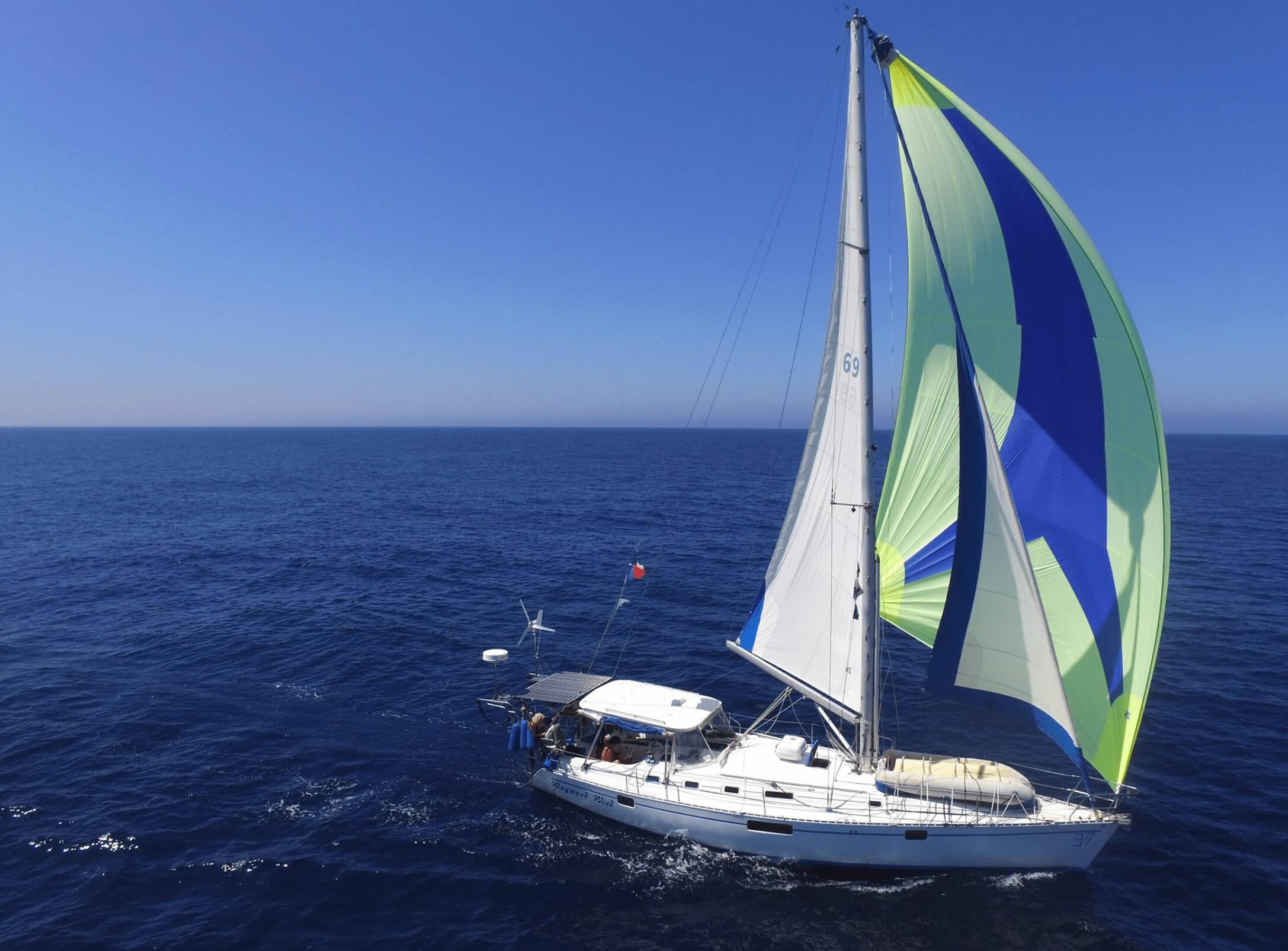
Photo: @windythesailboat
The Broke Backpacker is supported by you. Clicking through our links may earn us a small affiliate commission, and that's what allows us to keep producing free content 🙂 Learn more.
- Crossing the Pacific Ocean in a Sailboat – WHY?
- Sailing Routes Across the Pacific(and how long they take)
- Oh, the Places You’ll Go (during your Pacific passage)
- When to Jump the Pacific Puddle (so you don’t die)
- What You Will Need to Cross the Pacific Ocean by Sailboat
- FAQs About Sailing Across the Pacific
- Final Thoughts on Sailing Across the Pacific
- Buy Us a Coffee!
Crossing the Pacific Ocean in a Sailboat – WHY?
What kind of maniac dreams of sailing across the Pacific? What kind of person puts thousands of nautical miles between them and the nearest semblance of land?
The Pacific Ocean has been singing a siren song promising palm trees, balmy weather, and peaceful winds for centuries. You’re completely unplugged – so no damn Instagram! For many sailors – veteran and greenhorn alike – it is the ultimate, goldilocks cruising grounds.
“The principal difference between an adventurer and a suicide is that the adventurer leaves himself a margin of escape.” – Tom Robbins
To cross the Pacific Ocean by sailboat represents an accomplishment that no one can take from you. It is indeed an adventure of epic proportions. Long night watches, daily face-offs with the elements, fixing the umpteenth broken thing… it is no easy feat! But anyone with a little preparation and a bit of know-how can leave themselves a margin of escape.
With a little initiation into the trials and tribulations of boat life, a cornucopia of experience awaits the adventurer who sails across the Pacific.

Unlock Our GREATEST Travel Secrets!
Sign up for our newsletter and get the best travel tips delivered right to your inbox.
Sailing Routes Across the Pacific
(and how long they take)
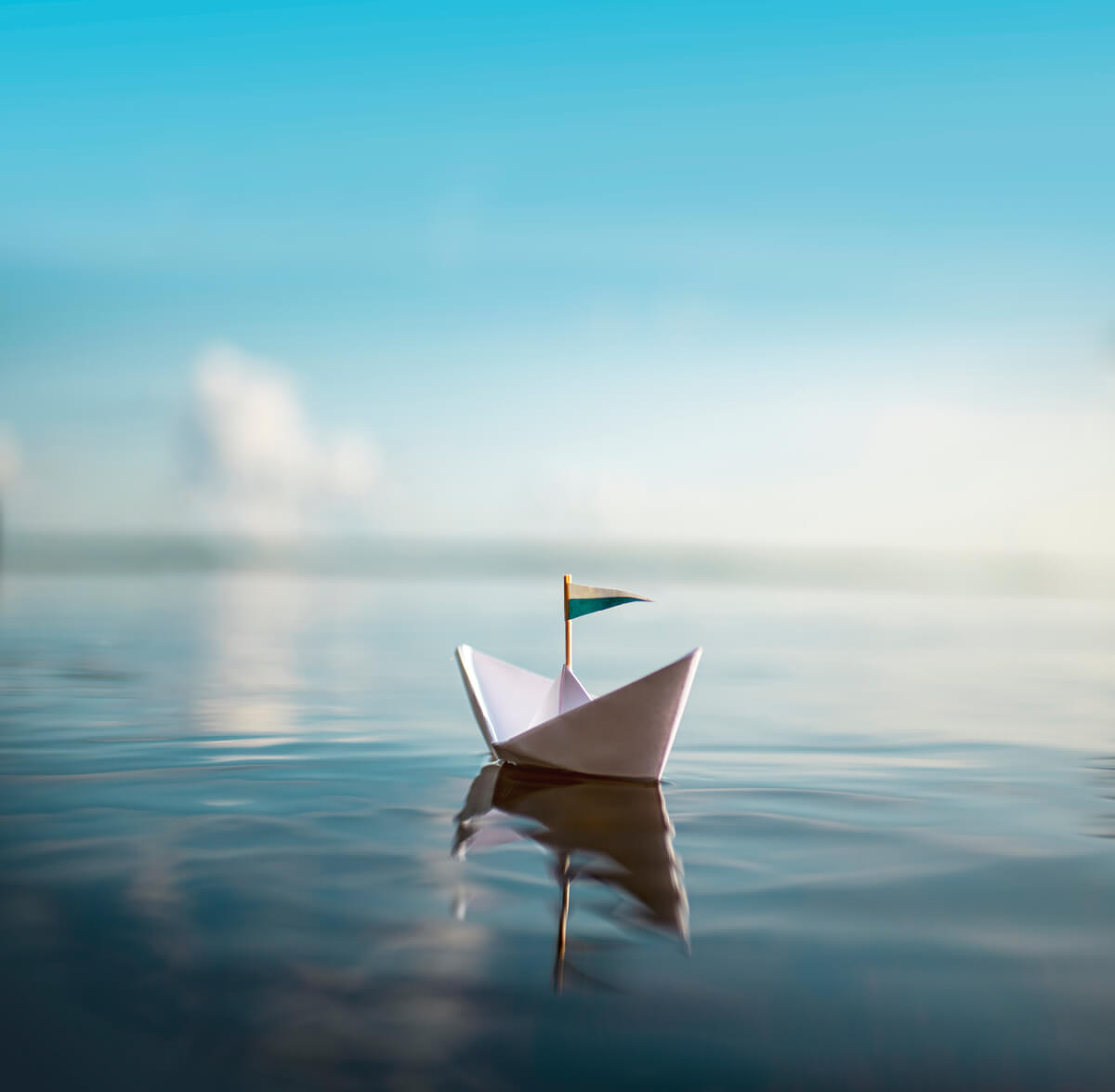
The sailor knows that there is no point fighting the wind. So, a successful passage across the Pacific depends on good winds. Generally speaking, this lends itself to an east-to-west crossing.
All good boat plans are written in the sand at high tide, so of course, there are some deviations from the popular route. But, there are still vague targets and timelines that guide your Pacific Crossing.
Sailing the Pacific Ocean from East to West – The Coconut Milk Run
From the moment Magellan stuck his nose out from Panama and declared it Mar del Pacifico, this is the route sailors have favoured.
Your trip can begin with a little visit to Panama, heading south to charge through the notorious ICTZ, and riding the south-easterly trades all the way to French Polynesia. Some will stop in and travel the Galapagos, others will charge on through.
How long does it take to sail across the Pacific from East to West? This passage can take anywhere from 23 to 40+ days in a sailboat.
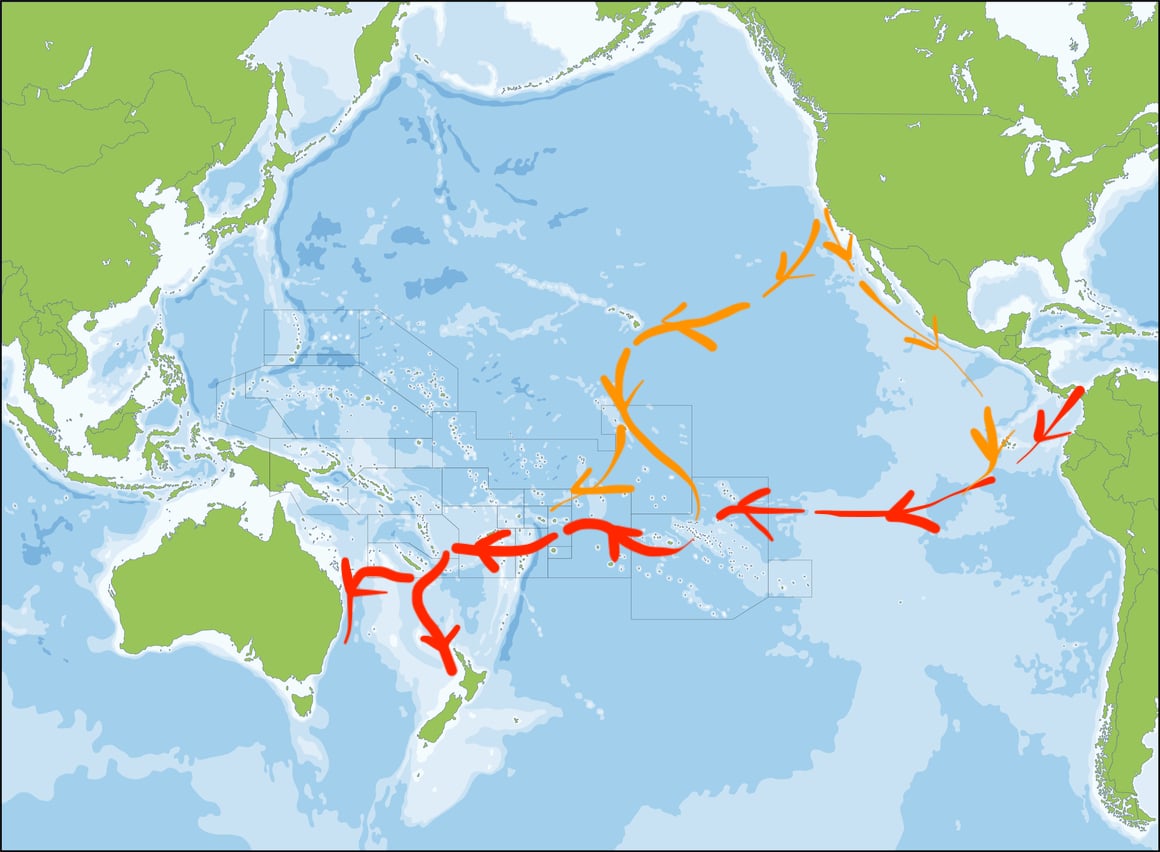
There are variations on this Coconut Milk Run. You can set off from Mexico or Ecuador, for example. Maybe this is part of a larger circumnavigation and you’re fresh off a season in sailing the Caribbean or an Atlantic Ocean crossing.
You can go onwards to Australia and New Zealand, or get stuck in the South Pacific. Even going on to travel Southeast Asia, or India, are not out of the question for the brave circumnavigator.
Wherever your starting point is in the east, you will spend a month (give or take) without seeing land. Just you in your tiny boat-universe traversing the sea and the stars.
Sailing the Pacific Ocean from West to East
Call me lazy, but this is a hard slog. Nothing is ever impossible, but you’ve got to have some patience with the winds to sail across the Pacific Ocean from west to east. If the early Polynesian navigators can do it, though, so can you and your tin can.
The three main options for sailing from west to east are:
- The “Direct Route”
- The Roaring Forties
- The Northern Route
Ok, I lied – I would love to do the Roaring Forties passage! Anyway, this is not about Indi’s Secret Planning to Cross the Pacific Ocean Again. This is Serious Writer Business.
So, the Direct Route has the disadvantage of it being primarily upwind. But if you’ve got a well-prepared boat – and well-prepared crew – it can be fast and exhilarating.
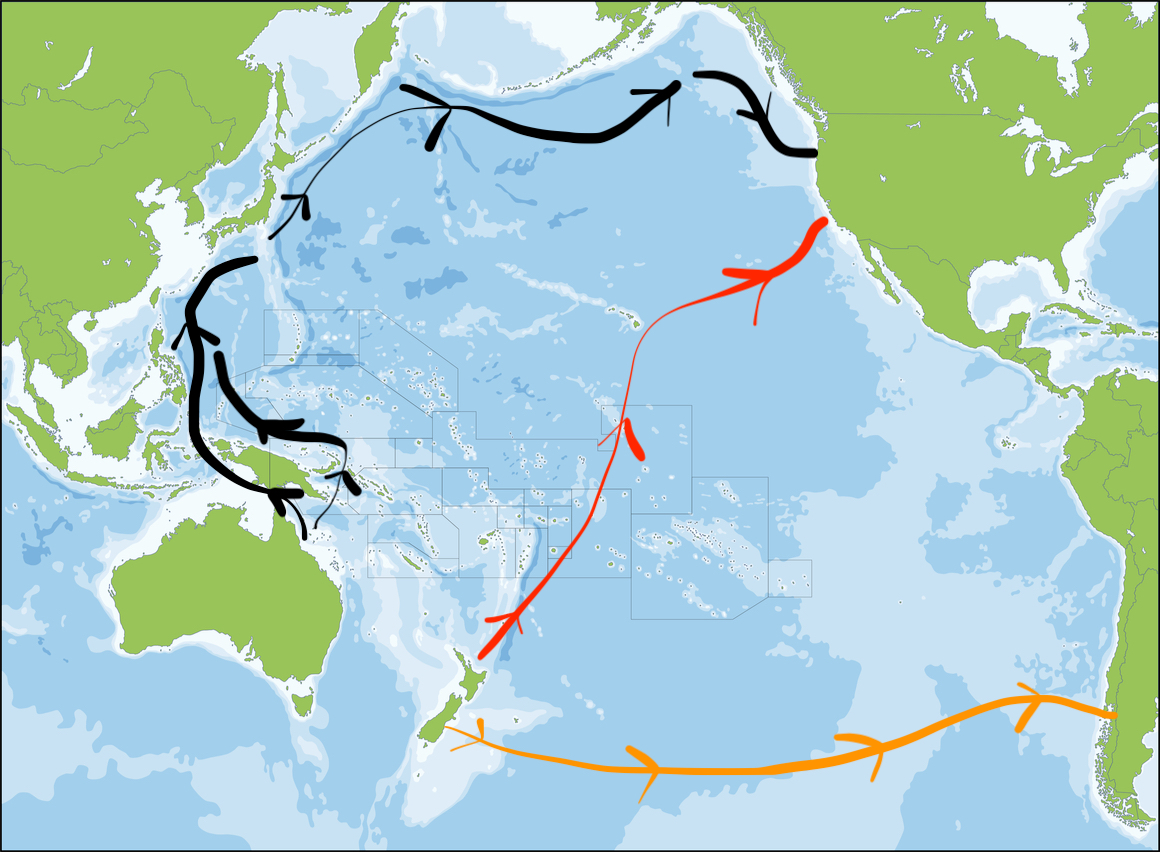
The Roaring Forties has broken stronger sailors than me. How long does it take to sail across the Pacific from West to East? Well, It’s a long passage – 40 to 50 days. Extreme latitudes and rolling seas mean you need a well-stocked boat – and hardy crew. Also, the point of cruising the Pacific is usually balmy weather. There’s not a lot of balmy weather down there, mate. But if you can hunt around for the right latitude, it’s downwind sailing (yay)!
And then there’s the Northern Route. Basically, this is several smaller passages up through the Coral Sea, through Southeast Asia and Japan, and then across the Northern Pacific. An EPIC bucket list adventure if I ever dreamed of one! You can hunt around for good wind on this passage, but again, you’ll need a resilient crew and boat ready to take on the many nautical miles to be covered.
Want to save money on accommodation?
Enjoy 20% OFF on stays ALL around the world.
Oh, the Places You’ll Go (during your Pacific passage)
If we look at a map of the Pacific Ocean, you’ll notice it’s mostly blue. On one side is the Americas, and somewhere over there is Australia and New Zealand.

But scattered across this great blue spectacular, are various incarnations of paradise on Earth.
Oh, the Pacific Islands! You marvellous little delights full of genuine offbeat travel!
Sailing in French Polynesia
After travelling Panama, or elsewhere in the Americas, you’ll likely arrive in French Polynesia.
There are three main groups of islands. There are the Marquesas, the Tuamotus, and the Society Islands. Your first port of call after the big crossing is likely going to be the Marquesas.
The Marquesas are epic volcanic islands that tower over deep waters. There is some cheeky hunting and epic hiking here, as well as cheap baguettes. It blew my mind that in the middle of the Pacific there was cheap, French bread!
However beautiful these islands are, though, the stereotypical shallow, blue waters teeming with coral reefs are not here.
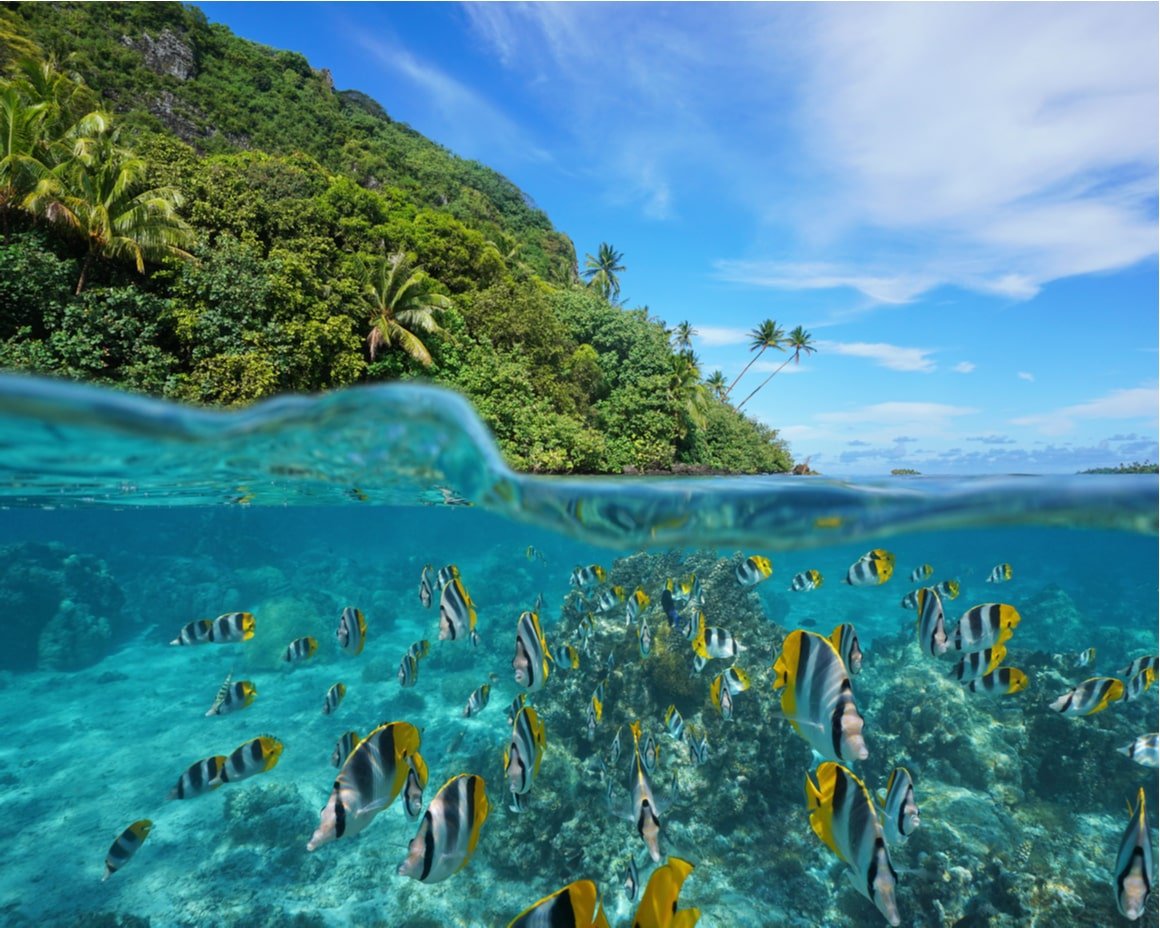
You must press on to the Tuamotus and Society Islands for that. I reckon you could get lost in the Tuamotus for a lifetime – as long as the freshwater doesn’t run out.
The world’s best scuba diving, spearfishing, and lazy hammock days are your juicy reward for crossing the world’s greatest ocean! Not too shabby.
Sailing in the Cook Islands
The Cook Islands Exclusive Economic Zone (EEZ) is 2 million square kilometres! You can’t expect to know this series of islands intimately in just one visit. Still, good fishing, chatty locals, and picturesque islands make it worth sailing through. Travelling to the Cook Islands (and briefly becoming a mermaid) may be just what you need to avoid travel burnout.

Palmerston Atoll is only able to be reached by boat. It is a series of islets whose inhabitants can all be traced back to one man – William Marsters. Island time becomes more prominent the further away from continents you get. So by the time you get to Palermston Atoll, you can throw your watch overboard!
Throughout the Cook Islands, a slow tempo to living is the norm. Expect to chat lots with strangers, explore uninhabited islands, and wonder why you’d ever return to “normal” life. If I ever end up on the run, don’t go looking for me (or my mermaid look-alike) in the Cook Islands! 😉
Sailing in Fiji
As you continue your westward sailing across the Pacific, you will probably make a stopover and stay in Fiji.
Fiji is a bit of a crossroads within the Pacific. It is both Polynesian and Melanesian, and it is also home to a large Indian diaspora. While much of the Pacific escaped a strong colonial presence, Fiji did not. Along with its own kingdoms and chiefdoms, the British stuck their nose in and left a muddy footprint on Fijian culture.
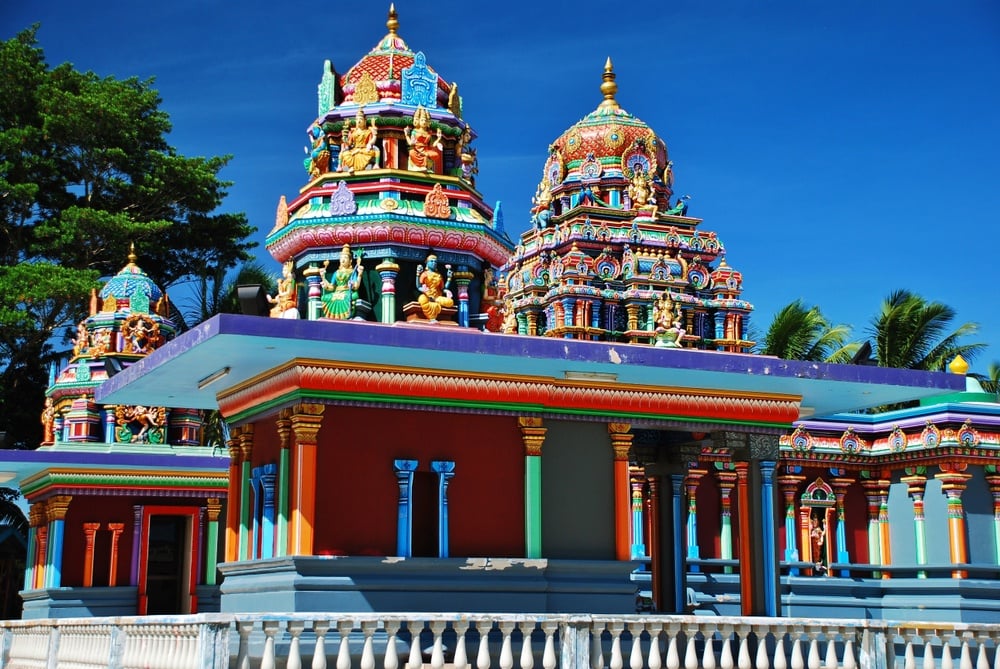
The British chose the rainiest place in the Pacific as the capital of their colony – Suva. Because of course, they did. Suva will probably surprise first-time visitors – it’s fewer palm trees and coconuts and more traffic and nightclubs.
Suva aside, the rest of Fiji is as remote and gorgeous as you’d expect the Pacific to be. Sailing through Fiji is a reminder that the Pacific is as complex as the rest of the world – it just has more white sand beaches!
Sailing to New Zealand
If you make it to New Zealand, pat yourself on the back! You crossed the Pacific freaking Ocean – fuck yeah!
If you take the east to west passage across the Pacific, chances are you’ll end up in Aotearoa, New Zealand. The kiwis are pretty comfortable with their status as a Pacific Island. Along with the first real supermarkets on this side of the Pacific, there are familiar smatterings of Polynesian culture.
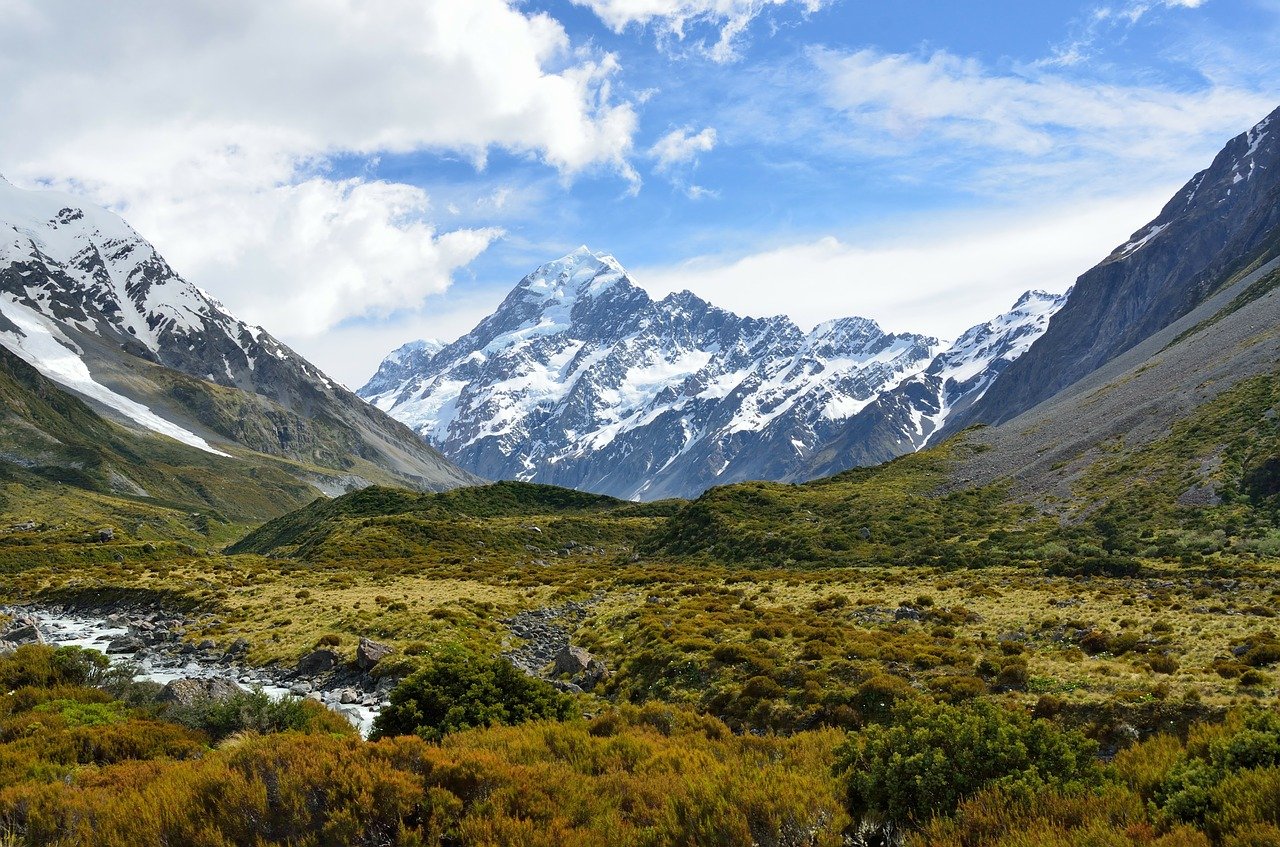
Dammit New Zealand, you’re pretty freaking sweet! Road tripping around New Zealand is bloody dreamy: the hiking and the mountains are off the charts, and the people are just so friendly! If there were ever a sticky place to tempt my wandering feet to settle down, it’d be New Zealand. Plus, the diving is pretty great.
Some sailors choose to sell their boats here. Some choose to slow down and spend a season working or exploring New Zealand. Eventually, most sailors have to move on. Travelling to New Zealand is a very special experience that will have most sailors scheming about how to get back!
Sailing to Australia
Maybe you bypassed New Zealand and came straight across the Pacific to Australia. Maybe you added crossing the Tasman Sea to your growing list of sailing achievements. However you made it, and whatever customs form you had to fill out to prove it, you arrived in Australia – the famed Land Down Under.
A pretty epic continent is bound to get under your skin. She’s bold, she’s beautiful, and she’s stinking hot! There are countless incredible adventures to be had in Australia!
Australia is less keen on embracing its geographical status as a Pacific or Asian country. It’s a whole different kettle of fish down under, mate.
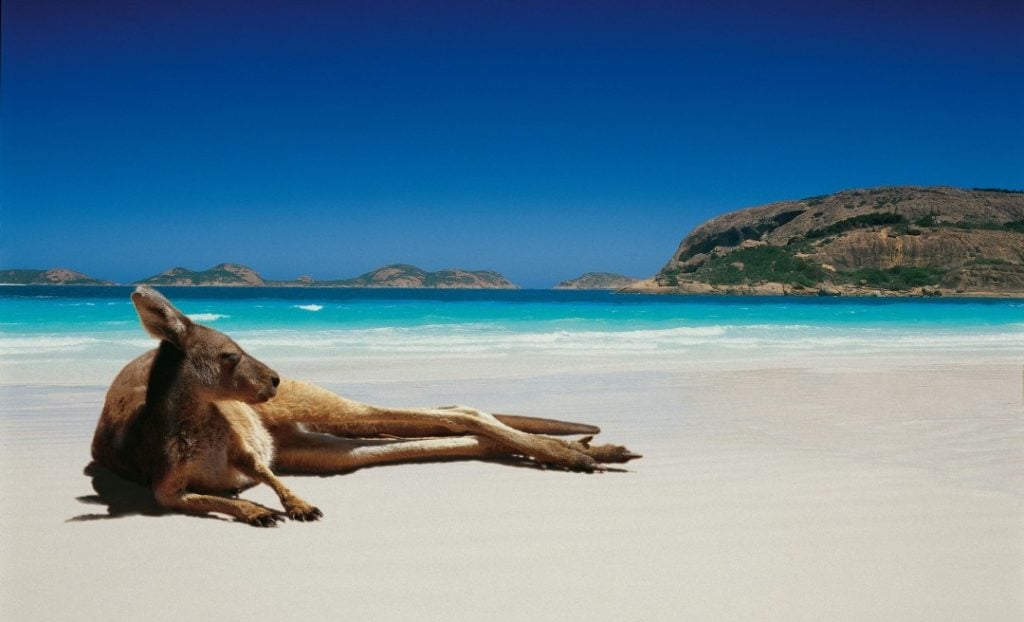
There are sweet Australian road trips, and working opportunities abound for the boat bum. You can easily restock the cruising kitty for a season before continuing your sailing circumnavigation. There’s also a pristine and sparsely populated coastline good for nothing but surfing and sailing!
I reckon the reason you don’t see too many Australian sailors around the world is that they see no reason to leave their beautiful home.

Wanna know how to pack like a pro? Well for a start you need the right gear….
These are packing cubes for the globetrotters and compression sacks for the real adventurers – these babies are a traveller’s best kept secret. They organise yo’ packing and minimise volume too so you can pack MORE.
Or, y’know… you can stick to just chucking it all in your backpack…
Get Yours Here Read Our ReviewWhen to Jump the Pacific Puddle (so you don’t die)
Danger is a relative concept. Crossing the street and driving a car is dangerous, but we all do it every day. Crossing the Pacific Ocean can be dangerous, but you can mitigate those risks.
People always ask me how bad the weather was at sea. Were there storms? They don’t ask about keeping healthy while travelling, breakdowns at sea, or navigation nearly as often. A storm holds a captivating spot in our psyche – and for good reason.
It’s worth remembering that your boat is probably stronger than you. You shouldn’t get into your life raft until you are stepping up into your life raft. Extreme situations aside, there are safer times to cross the Pacific! And more comfortable times too. So when is it best to sail across the Pacific Ocean?

The boat sinking storms are concentrated in hurricane or cyclone season. Luckily, these seasons are quite well known now. If you are in the South Pacific between November and April, your chances of a cyclone are high. But, come May, the odds drop to almost zero. Cyclone season in the North Pacific and the Caribbean is June through November.
With this in mind, the best time to sail across the Pacific Ocean becomes clearer. If you leave Panama around March, you will arrive in the South Pacific right at the beginning of the best cruising season. You will also avoid the cyclone season of the Caribbean.
There’s no point fighting the winds, man!
What You Will Need to Cross the Pacific Ocean by Sailboat
You need a sailboat that is stem to stern ready. You also need a crew that is in tip-top shape and mentally prepared for the long passage ahead. Realistically, anyone who is prepared can take on sailing across the Pacific Ocean. But what does it look like to be prepared?
The Trial by Sailboat – LIVEABOARD EXPERIENCE!
Before literally chucking yourself in the deep end by sailing the Pacific, why not rent the boat life? Try your hand at skippering a sailboat bareboat (without captain or crew) so you can stress-test yourself as a sailor. Sailo lets you do exactly that!
You can rent one of over 30,000 boats. If you’re not up to skippering your own boat, then kick back on one of the many catered charter boats on offer! You’re guaranteed to find something suitable and have a splashing good time in the best places in the world to sail.
It’s not the most hardcore jump-in-the-deep-end training for your Pacific passage, but having a taste of the boat life is probably a good idea! It’d be a bit awkward if you got halfway across the Pacific only to realise this whole boat life wasn’t for you.
Boat System Preparation
Being prepared to sail across the Pacific Ocean means knowing your boat at least as well as you know your smush buddy.
I like to remember that a day spent preparing in the dock is worth a week at sea. When you walk around your boat, ask yourself: how likely is this to break, and if this broke, could I fix it? Preparing systems and the backup systems to backup systems is all part of your preparation.
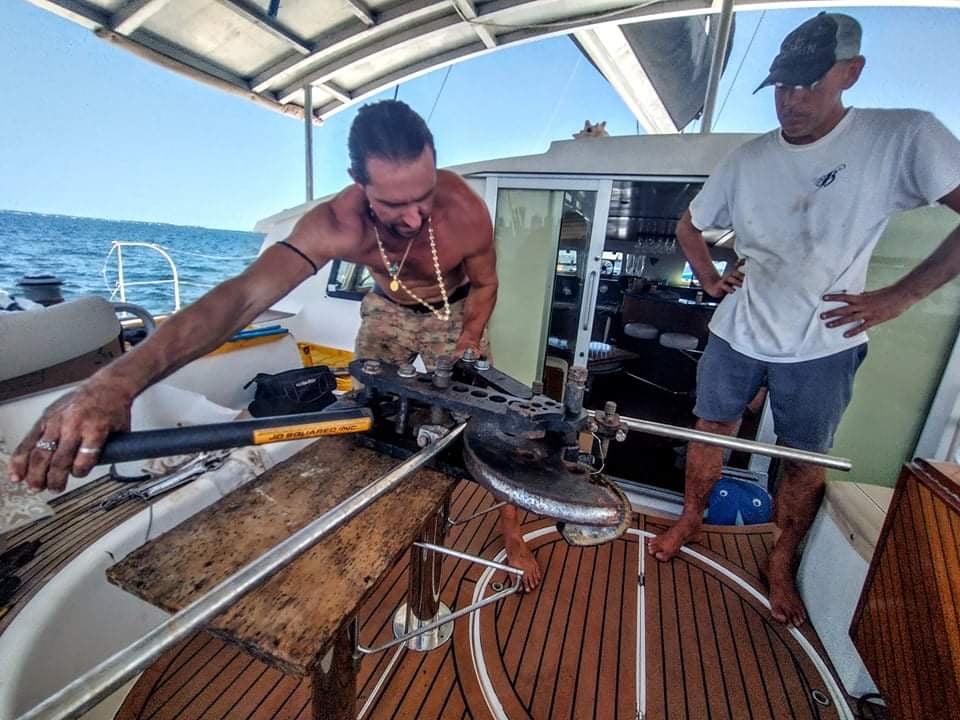
Photo: @windythesailboat
Ultimately though, you need to be flexible. You might not leave port knowing how to sew anything more than a button to your pants. But if push came to shove, you would learn real fast to mend your sail.
Knowing how to use both charts and electronic navigation is useful. Keeping in touch via the radio is also a useful – and fun – way of getting weather and gossip. Nothing says boat life like a radio crackling to life somewhere off the coast of Ecuador.
“Hola amigo, cual es tu posicion? Y cuidado con los monstruos!” It’s the first voice you’ve heard in over nine days that didn’t originate from you or your crew. It’s a comfort knowing there’s someone else out there also afraid of the sea monsters!

Essentially, being prepared is about organisation and organisation is about lists.
- Galley lists
- Maintenance lists
- Medical supplies list
- Weather lists
- Reading lists
Aside from adequate supplies, navigation and maintenance know-how, you need to have an adequately prepared crew.

Things go wrong on the road ALL THE TIME. Be prepared for what life throws at you.
Buy an AMK Travel Medical Kit before you head out on your next adventure – don’t be daft!
Buy on REISailing Solo Across the Pacific?

An adequate crew may look like just you, yourself, and you. That pun didn’t really work in the third person, but we’re rolling with it.
Sailing solo for long passages like that which is required to cross the Pacific is not unheard of. It is often the preferred way of sailing for old salts. And there is a certain appeal in the solitude of a long passage – it’s the ultimate growth at the edge of your comfort zone.
The biggest hurdle to solo sailing is standing watches. It’s hard to maintain a constant watch and get enough sleep. Usually, a system of radar alarms, twenty-minute nap alarms, and a dash of faith in King Neptune get the solo sailor to their next port.
Knowing yourself and what you are capable of as a sailor is alluring though. Because no matter how well you know another person, you’re always going to know them better (for better or worse) after a long ocean passage.
To Crew or Not to Crew While Sailing Across the Pacific
A big advantage to having two, three, or more, people crewing a Pacific crossing is the night watches. Adequate sleep is a severely underappreciated necessity! Being able to divide the days and nights into shifts means that everyone gets to eat better and sleep better.

Photo: @themanwiththetinyguitar
But managing dynamics in close confines, far away from any time out spaces, is key. Your friend might be a perfectly competent sailor. When on land you notice that they chew with their mouth open and sometimes like to rant about how the world is going to end in the next ten years.

This is all good when you can leave the bar and have a break from them. All is good when you do small passages with them. But, when you’re in a small sailboat in the middle of the Pacific Ocean, you may not want to hear about the apocalypse for the twelfth time in as many days while watching food entirely miss their mouth.
Vanlife has a reputation for making or breaking relationships. Sailboat life is essentially vanlife without the ability to go for a hike and ignore your partner for a while. There’s also the added dynamic of captain vs crew.
With good communication, sailing across the ocean with your partner can create an unshakable bond that transforms and solidifies your partnership. Without good communication, you might not ever want to see that dickweed’s face again.
So, to crew or not to crew? Personally, I think we’re stronger together than we are apart. I think that sailing across an ocean is a sublime experience that is made easier and more pleasurable when shared. BUT, you need to be honest and aware of the dynamics. Play to your strengths and be accepting of others – and your own – weaknesses.
Mama Moana has a way of humbling us all.
Boat Food is Good Food
To sail across the Pacific, you’re going to need food – obviously! 😉 Each boat will have different capabilities when it comes to storage and fridge capacity, so fresh food may last better on some boats than others.
After a month at sea, cooking is bound to get creative though. Add in the challenges of cooking underway and fatigue and you are primed to get creative in the galley!
Food is fuel and a happy gut makes for a happy mind. Things like lemons that keep well for weeks become a godsend. Rather than see food as a cumbersome challenge, think of it as a means for innovation.

I had a captain who learned to make his own yoghurt. Another who pickled their own foods. Every boat I’ve been on has had its own take on the one-pot curry. Skills like salting fish and baking bread become more accessible when you’ve got nothing but time on your hands!
Sailing across the Pacific is made easier with good supplies and a creative touch in the galley! If all else fails, high protein and high sugar snacks like peanut butter make the night watches go quicker!
Fishing While Crossing the Pacific Ocean
A way to supplement your supplies – and provide some entertainment – is to fish while underway. There are some great books and resources made by far better fishermen than me on this matter.

Typically trolling while underway is the method cruisers go for. Once sailors finish the Pacific crossing, having a spear gun or some fishing poles opens up a world of island adventures!
Let’s face it, there’s nothing quite like fresh ceviche!
The Tools You Need to Sail Across the Pacific
There is no way for me to write a succinct list of all the tools you need to sail across the Pacific Ocean. For every system on the boat, you need tools to maintain and repair it. But I wouldn’t want to leave port without:
- Good tool bag and spare parts
- Watermaker
- Deck knife (my ever faithful favourite tool)
- Coffee pot
- Sewing machine
- Multi-tool (my secret second love)
- Solar panels
- Spinnaker
Staying Safe at Sea
Something sailors – veterans and newbies alike – tend to do is underestimate the consequences of danger. I guess you have to have a certain cognitive dissonance to cast off and not see land for over a month! Maybe it’s called getting old – or one too many close calls – but having insurance kind of puts your rational mind at ease.
You can release your wild side – but you’ve insured its dumb ass!
ALWAYS sort out your backpacker insurance before your trip. There’s plenty to choose from in that department, but a good place to start is Safety Wing.
They offer month-to-month payments, no lock-in contracts, and require absolutely no itineraries: that’s the exact kind of insurance long-term travellers and digital nomads need.
SafetyWing is cheap, easy, and admin-free: just sign up lickety-split so you can get back to it!
Click the button below to learn more about SafetyWing’s setup or read our insider review for the full tasty scoop.
Books and entertainment
Even when on night watch, you need something to keep you occupied. Even between fixing and tinkering things, there is a lot of time when you sail across the pacific. Most sailboats tend to be dry while underway, so there aren’t too many opportunities for drug bending entertainment.
I would recommend downloading podcasts, music, and books GALORE. I personally found movies kind of annoying to sit through, but that’s just me — I know some sailors who smash through tv series like there’s no tomorrow on passage!
What’s important is that you keep your mind occupied. Plus, when do you get a month of uninterrupted learning in your adult life? Why not start learning a new language while sailing?
There are many good books to read while travelling. I think I powered through close to forty books in the first Pacific passage I was on. A couple of books good for the mind at sea are:

- This Old Boat by Don Casey. This is the handiest and easiest how-to fix your broken boat book that I’ve found. There are beginner projects that are best tackled in port, and advanced fixes that’ll save your butt once your in the middle of nowhere. Plus, it’s super interesting!
- Storm Tactics by Larrey Pardey. Pretty self explanatory! And an all round interesting read. In a storm at sea, luck is highly biased toward the sailor who has a plan. A series of user-friendly checklists will help sailors from the moment they start looking for their perfect offshore boat, through outfitting, and as they encounter their first storms at sea.
- Swell by Liz Clark. Captain Liz Clark spent her youth dreaming of traveling the world by sailboat and surfing remote waves. When she was 22, she met a mentor who helped turn her desire into reality. Embarking on an adventure that most only fantasize about, she set sail from Santa Barbara, California, as captain of her 40-foot sailboat.
- Rum Diaries by Hunter S. Thompson. Begun in 1959 by a 22-year-old Hunter S. Thompson, The Rum Diary is a brilliantly tangled love story of jealousy, treachery, and violent alcoholic lust in the Caribbean boomtown that was San Juan, Puerto Rico, in the late 1950s. It’s nice to escape the boat and fall into the drugged up party land of Hunter S. Thompson.
- At the Existentialist Cafe by Sarah Bakewell. Paris, near the turn of 1932-3. Three young friends meet over apricot cocktails at the Bec-de-Gaz bar on the Rue du Montparnasse. They are Jean-Paul Sartre, Simone de Beauvoir and their friend Raymond Aron, who opens their eyes to a radical new way of thinking. No book is better suited to boat life than one about existentialism.

Our GREATEST Travel Secrets…
Pop your email here & get the original Broke Backpacker Bible for FREE.
FAQs About Sailing Across the Pacific
Final Thoughts on Sailing Across the Pacific
If the Pacific calls and promises fresh fish, palm trees, and island time – you’ve got to answer! And there is no better way to travel the Pacific than by sailboat. So do your stem to stern inspection, steel your nerves, and cast off to sail across the Pacific Ocean.
The crushed peach sunsets and clear, stargazing nights will reward you tenfold. There are dreamy island paradises scattered across the great blue spectacular and hefty continents on the other side.
Crossing an ocean by sailboat is no small feat. But every mammoth task is made up of smaller puzzle pieces that come together. It is something quite spectacular to crack a beer on the other side of the Pacific knowing that those nautical miles were earned.
Sailing is the ultimate slow travel. An odyssey of mythical proportions lies ahead of the intrepid sailor who takes on such a crossing.
Avast and fair winds, fellow sailors. I’ll see you somewhere in the South Pacific! 😉
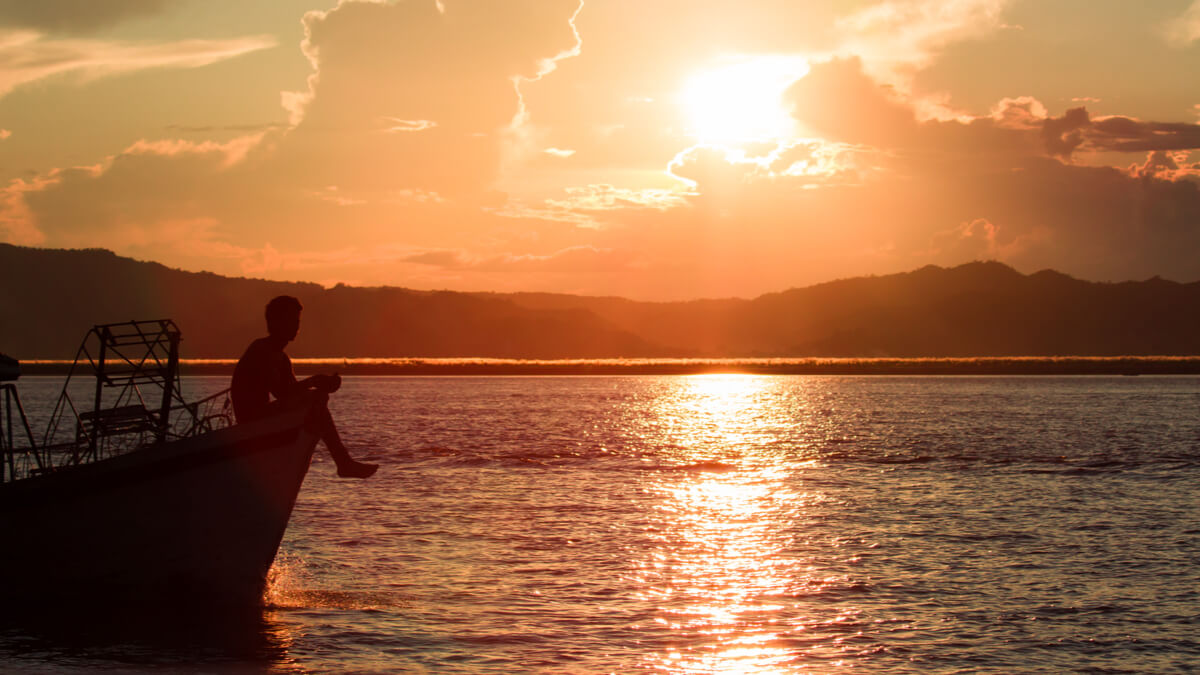
Buy Us a Coffee!
A couple of you lovely readers suggested we set up a tip jar for direct support as an alternative to booking through our links. So we created one!
You can now buy The Broke Backpacker a coffee. If you like and use our content to plan your trips, it’s a much appreciated way to show appreciation 🙂








